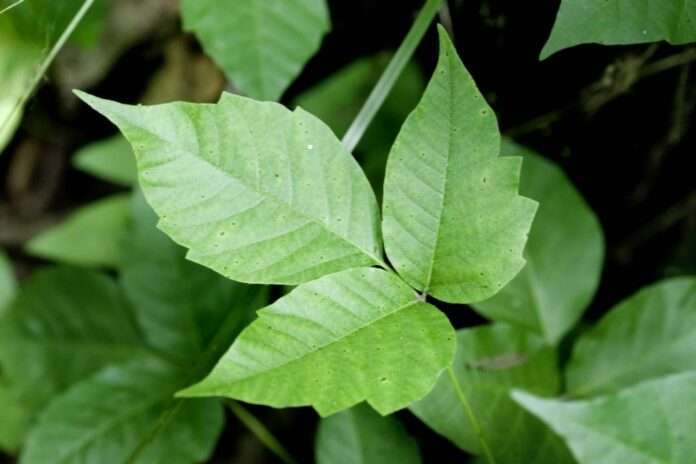Knowing how to identify poison ivy is key to avoiding contact
MANHATTAN, Kan. – Most gardeners and outdoor enthusiasts have heard at least some version of the popular refrain to help them stay clear of poison ivy.
‘Leaves of three, let them be.’
The saying points out the defining feature of poison ivy; that is, three leaflets per leaf protruding from a vine and containing urushiol, an oil that causes a rash in most people.
During the growing season – typically spring and summer – poison ivy is easy to distinguish from the Virginia creeper, a vine with five leaflets. Virginia creeper does not contain urushiol and typically does not cause a rash.
“However, during the winter, distinguishing between the two vines can be more difficult because the leaves have dropped,” said Ward Upham, a horticulture expert at Kansas State University.
Poison ivy can still cause a negative reaction during the winter, so it’s important to be able to identify the vine without its’ three-leaflet clue.
“This is actually easy to identify once you know what to check,” Upham said. “Look at the aerial roots. On poison ivy, they are hair-like, but on the vine of the Virginia creeper they are more plump and about the size of a pencil lead.”
Upham noted that urushiol can cause a rash 1 to 5 years after a plant has died. The amount of urushiol that covers the head of a pin can cause a rash in 500 people, he said.
“Poison ivy can grow as ground cover, a shrub or a vine,” he said. “Using a chainsaw on poison ivy in the winter can release sap which makes a rash more likely. This is worse on warm days where there is more sap rise.”
Upham and his colleagues in K-State’s Department of Horticulture and Natural Resources produce a weekly Horticulture Newsletter with tips for maintaining home landscapes. The newsletter is available to view online or can be delivered by email each week.
Interested persons can also send their garden- and yard-related questions to Upham at [email protected], or contact your local K-State Research and Extension office.
Sidebar
Vegetable, fruit All-America Selections announced
All-America Selections, a non-profit organization that tests never-before-sold plant varieties for the home gardener, has announced its set of winners for 2021.
K-State horticulture expert Ward Upham highlighted a few of the winners in a recent issue of the university’s horticulture newsletter. They include:
• Vegetables – Echalion Crème Brulee, Pepper Pot-a-peno and Squash Goldilocks. All are edible varieties.
• Flowers – Celosia Kelos Candela Pink, Leucanthemum Sweet Daisy Birdy and Zinnia Profusion Red Yellow Bicolor. Each is available in plant form.
A complete list of winners is available online.
FOR PRINT PUBLICATIONS: Links used in this story
K-State Horticulture Newsletter, https://hnr.k-state.edu/extension/info-center/newsletters/index.html
K-State Research and Extension local offices, www.ksre.k-state.edu/about/stateandareamaps.html
All-America Selections 2021 winners, https://all-americaselections.org/winners
K State Research and Extension is a short name for the Kansas State University Agricultural Experiment Station and Cooperative Extension Service, a program designed to generate and distribute useful knowledge for the well being of Kansans. Supported by county, state, federal and private funds, the program has county extension offices, experiment fields, area extension offices and regional research centers statewide. Its headquarters is on the K State campus in Manhattan. For more information, visit www.ksre.ksu.edu. K-State Research and Extension is an equal opportunity provider and employer.
Story by:
Pat Melgares
785-532-1160
[email protected]
For more information:
Ward Upham
785-532-6173
[email protected]





